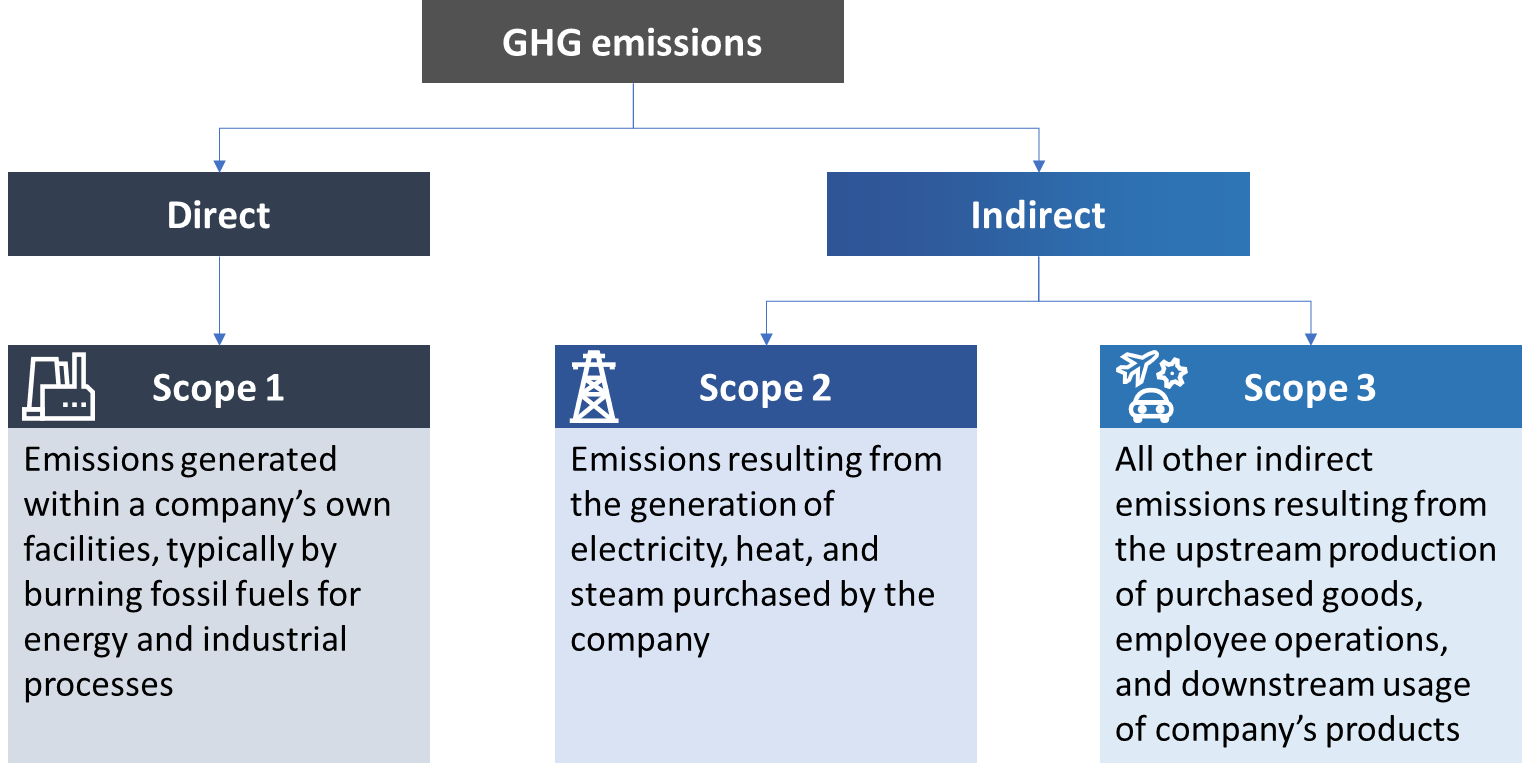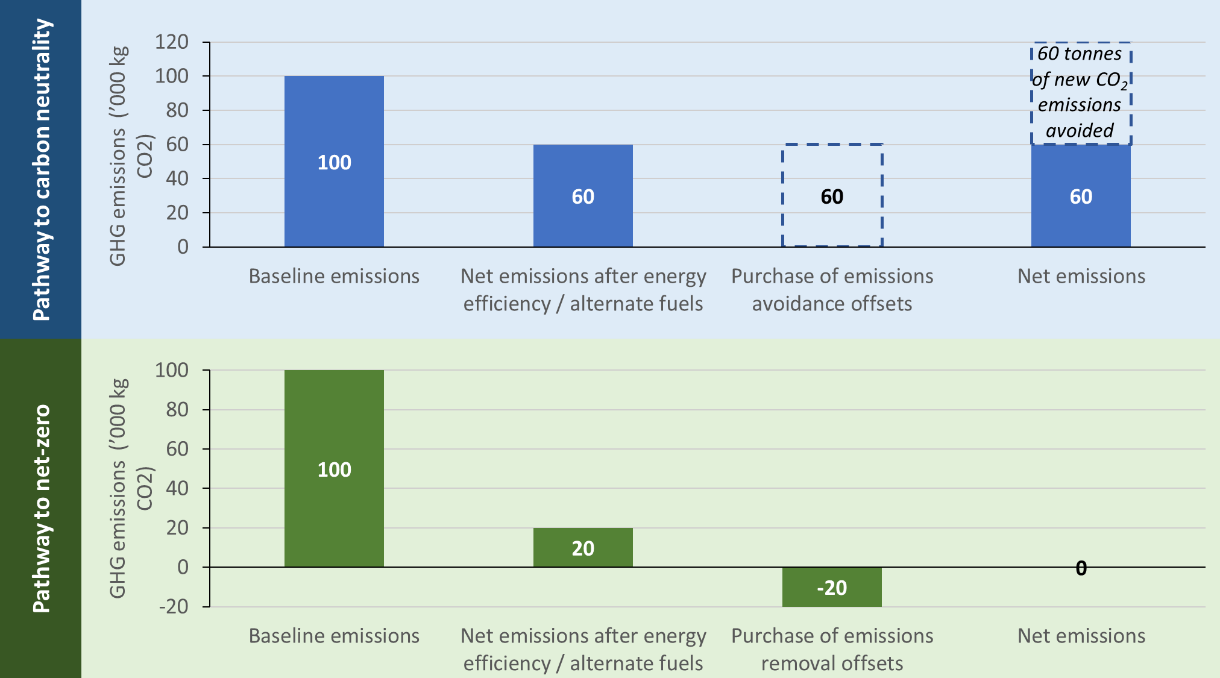In the first part of this series, we explained net-zero targets for countries. In this piece, we discuss net-zero for corporates.
Context
As of November 2021, over 350 corporates across the world have announced net-zero pledges.1 These large companies play a pivotal role in ensuring that nations meet their targets. Companies follow well-established international standards like the Greenhouse Gas Protocol to calculate emissions. They classify emissions according to three categories – scope 1, 2, and 3.
Figure 1 shows that emissions from operations at company-owned facilities – such as from using coal in steelmaking – are scope 1 or direct emissions. Indirect emissions occur at facilities owned by other companies or individuals; scope 2 emissions are caused by the generation of purchased electricity and heat. Scope 3 covers all other indirect emissions, such as those from employees’ commutes and the entire supply chain, from upstream suppliers to downstream consumers.
Figure 1: Companies classify emissions according to three categories

Source: The Greenhouse Gas Protocol, “A Corporate Accounting and Reporting Standard,” accessed October 26, 2021, https://ghgprotocol.org/sites/default/files/standards/ghg-protocol-revised.pdf.
Why is abating scope 3 difficult?
Corporate net-zero targets typically include scope 1 and 2 emissions. However, scope 3 targets are usually absent or unambitious. Companies rarely report their full scope 3 emissions, as the involvement of multiple stakeholders across the supply chain complicates the calculation.
Scope 3 emissions, particularly from product use, are significant for many companies. For example, a refinery’s flagship product is vehicular fuel, which emits large quantities of CO2 when used. In 2020–21, the Indian Oil Corporation estimated that its scope 3 emissions were almost eight times the sum of its scope 1 and 2 emissions.2 Similarly, an asset manager’s product is the capital invested in carbon-emitting businesses like steel and cement manufacturing. While such emissions do occur at facilities owned by other companies, large corporations can influence their supply chains and create a more significant decarbonisation impact.
Is the target net-zero or carbon neutral?
Many companies across the world have declared that they are now ‘carbon neutral’. Figure 2 illustrates the difference between carbon neutrality and net-zero. Both pathways focus on cutting emissions by improving efficiency and adopting clean energy. A carbon-neutral company then purchases emission avoidance offsets, i.e., projects that avoid new CO2 emissions by, for instance, preventing deforestation. This does not bring a company’s net emissions to zero but allows it to claim that it has a positive environmental impact as it supports green projects.
A net-zero company purchases emission removal offsets, i.e., projects that remove the existing CO2 from the atmosphere through, for instance, carbon capture. However, this offset category makes up less than five per cent of global inventories.3
Figure 2: Net-zero requires a significantly more stringent pathway than carbon neutrality

Source: Torill Bigg, “What’s the Difference Between Net-zero and Carbon-neutral Policies?” Renewable Energy & World, September 1, 2021, https://www.renewableenergyworld.com/policy-regulation/difference-between-net-zero-and-carbon-neutral-policies/.
Some emission avoidance offsets help fund green projects in vulnerable communities, such as forest protection and energy access. However, global investigations find that these projects are poorly monitored and frequently overstate their impact.4 Further, research suggests that the benefits of emission removal offsets may be lower than expected due to asymmetries in the carbon cycle and natural variations across a carbon sink’s lifetime.5
Relevance and impact
Companies must provide accurate baselines of their full emissions and establish a strategy to reach net-zero. Adhering to independent standards such as the Science Based Targets Initiative’s Net-Zero Standard would help build credibility. Large corporations can leverage their influence to decarbonise the whole supply chain. While offsets are expected to remain a part of near-term corporate action, companies should prioritise deep emission cuts before buying offsets. Regulators and consumers can prevent greenwashing by understanding the need for, and the pathways of, net-zero pledges.
Read Part 1: CEF Explains net-zero…for countries
References
- [1] “Net Zero Tracker,” accessed November 1, 2021, https://zerotracker.net/.
- [2] IOCL, “Energising India Responsibly and Sustainably: Sustainability Report 2020-21” (New Delhi: Indian Oil Corporation Limited, 2021).
- [3] Jess Shankleman and Akshat Rathi, “Net Zero Is Hard Work, So Companies Are Going ‘Carbon Neutral,’” Bloomberg Green, July 19, 2021, https://www.bloomberg.com/news/articles/2021-07-19/offsets-can-play-a-role-to-make-companies-carbon-responsible.
- [4] Ben Elgin, “These Trees Are Not What They Seem,” Bloomberg Green, December 9, 2020, https://www.bloomberg.com/features/2020-nature-conservancy-carbon-offsets-trees/.
- [5] Kirsten Zickfeld, “Guest Post: Why CO2 Removal is Not Equal and Opposite to Reducing Emissions,” CarbonBrief, June 21, 2021, https://www.carbonbrief.org/guest-post-why-co2-removal-is-not-equal-and-opposite-to-reducing-emissions


